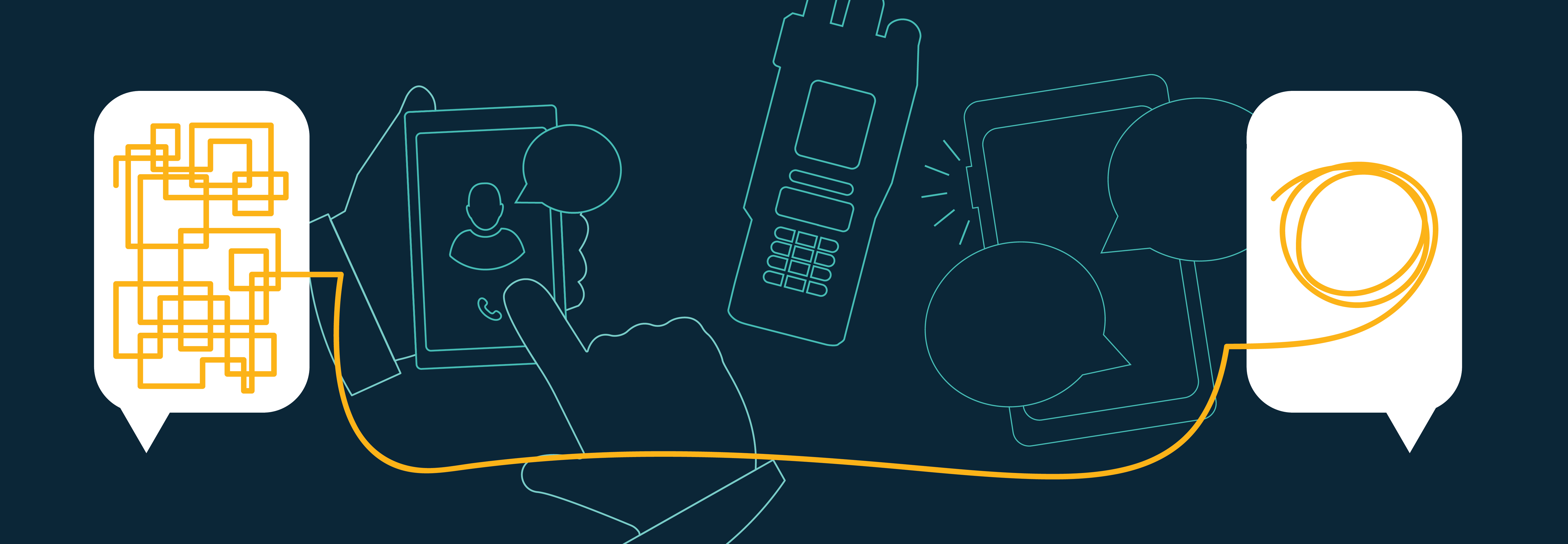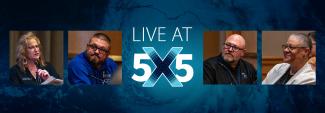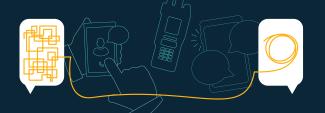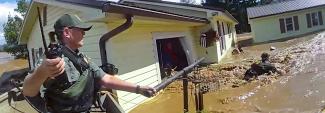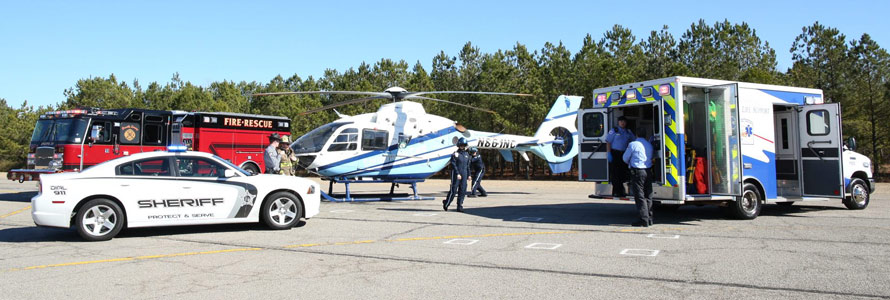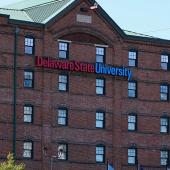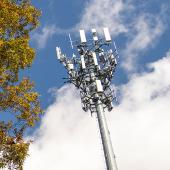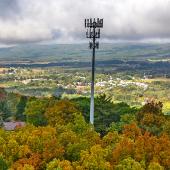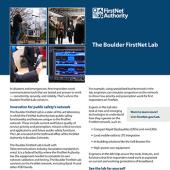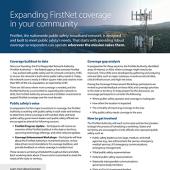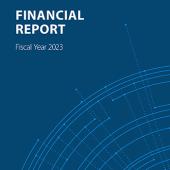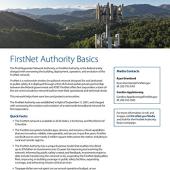Summary
Guest
Molly Hahn, Public Affairs Specialist, FirstNet Authority
Barry Leitch, Senior Device Engineer, FirstNet Authority
Transcript
Preview
Narrator: You're listening to Public Safety First, a podcast to help you learn about the First Responder Network Authority and how you can be part of the future of public safety technology.
And now, your host.
Narrator: You're listening to Public Safety First, a podcast to help you learn about the First Responder Network Authority and how you can be part of the future of public safety technology.
And now, your host.
Molly Hahn: Hello and welcome to another edition of At Its Core, the podcast here at the FirstNet Authority, where we take technical topics and detangle and demystify them so that the average person can understand them. I am Molly Hahn, a public affairs specialist here at the FirstNet Authority, and I have to admit that I am a little nervous for this one. This was an incredibly technical topic, and I am excited to be here with Barry, who is going to make it so that we all walk away learning something about push to talk solutions and the inner workings with land mobile Radio. Welcome, Barry. Why don't you tell us about yourself and your role at the FirstNet Authority?
Barry Leitch: Well. Thank you. My name is Barry Leitch, and I'm a member of the FirstNet Boulder Lab team, where I support the Boulder lab and a range of engineering activities. I've been with the FirstNet Authority for close to 11 years, and have worked as an electronics engineer in the cellular industry for over 29 years. One of my responsibilities within the lab team is supporting the LTE LMR in a working demonstration as part of the Boulder Lab Tour.
Molly Hahn: Excellent. So you've got a deep history and kind of a real technical nitty gritty of this. I know that public safety agencies have invested a lot of money into some sort of land mobile radio system. What does that really look like?
Barry Leitch: It basically is the legacy voice public safety communication system. It's made up of radios of different technology. So it's very voice centric communication to this point. Basically, it's a communication system that has been evolving over the years, and they rely upon it for very critical communication needs, and they are very concerned about if they switch to another technology that supports the same level of critical needs for them.
Molly Hahn: So, you mentioned that it's evolved over time. Correct me if I'm wrong. This push to talk over cellular or broadband PTT, that's the new wave of what's coming. Not that we don't still have LMR, but what is broadband push to talk, and what are some of those benefits we get from moving into that new phase?
Barry Leitch: Sure. Push to talk over cellular enables instant voice communications over cellular networks so that one to 1 or 1 to many voice communications can happen at the push of a button. So it's just like talking on the legacy radios, but you're using an app on a smartphone or a dedicated, specialized push to talk device. It is part of what is called mission critical services, which includes push to talk. Voice. Video and messaging. Data services. And one thing I'll mention. Mission critical term for this is really from the three GPP standards based term that they use for this category of services. It's not necessarily what public safety could say is mission critical at this point. They would have to do their own vetting and confirmation of that to meet their needs. Some of the benefits of this technology is they can be cheaper. You don't have to have your own LMR network deployed, and the devices are much less costly than LMR radios. You can offload some of your LMR traffic to lower priority users using cellular. It can also help fill some of your coverage gaps by providing a more resilient network where you could potentially access cellular networks where you have marginal LMR coverage or way outside your coverage area. Cellular devices also can leverage Wi-Fi for indoor locations if there is more. Coverage issues indoor in some cases, and then PTT over cellular also supports the higher bandwidth requirements of video and data transmission and messaging and location tracking that maybe traditional LMR systems really can't support.
Molly Hahn: Interesting. So, it sounds like this is something that kind of goes a bit above the radio. What else does PTT offer?
Barry Leitch: It supports the standard talk group capability. In this case, it's a virtual talk group. It also supports 1 to 1 direct private calls. You get metadata with your transmissions to that gives you traffic data and user ID information in your transmissions. But it has a wider range of location based services support where you can actually provide your location information back to dispatch or to other users, and you can actually see it on the smartphone device. The other users within your group and it supports emergency activation calling and as LMR legacy systems do. It provides the same capability where you can activate emergency and and it could end up providing additional information of the user that activated that emergency.
Molly Hahn: I think if you are somebody who kind of has a general view of public safety, you really only think about, oh, click radio, okay, click off radio. But this really gives you a lot more detail about what that first responder is seeing or doing or rather located. And so what does this mean for someone who uses FirstNet? What is the push to talk solution available on FirstNet?
Barry Leitch: Yeah, for FirstNet, there are two major categories of talk over cellular support. There's the over-the-top solutions, and the more the standards based mission critical solutions, over-the-top solutions are commercially available. They're not really carrier integrated, and they have little to no cost in some cases and have more flexible deployment options. But these options are proprietary and not bound to three GB standards for mission critical solutions. And on FirstNet, they have the same priority as other public safety traffic, such as calls web browsing data access because basically they utilize the default bearer connection to the network.
Molly Hahn: Before we get to the mission critical solutions, I'm just curious if I'm getting this right. These are easier to deploy options, but if I'm using an over the top solution as a first responder, my traffic on the PTT app will be the same priority as my partner who's trying to make a call. What's different about these mission critical solutions you've mentioned?
Barry Leitch: For the standards based, mission critical solutions, they do have a unique advantage on FirstNet of this highest level of priority priori connection to the network, so they do have quality of service priority over other public safety traffic. They also must adhere to standards outlined by three GPP, ensuring that they're more closely meet the mission critical needs of the users. These apps on FirstNet are also unique in that FirstNet Authority experts work to verify and validate that they truly meet mission critical standards. That is one of the key areas of performance and capacity testing that the older FirstNet lab supports in actually testing these solutions and the priority that they're providing. They're not quite as flexible. They need to have an admin deploy them and configure them as appropriate for the agency. There are also a number of options for LMR to cellular 4G, LTE into working to allow a using agency to combine an LMR group with a cellular or broadband PTT talk group.
Molly Hahn: That's interesting to me that this is something we talked with Mark Lippert about standards that really is kind of agnostic to carrier, and we love to see that it can be something that anyone can benefit from. You mentioned, though, that it seems like there's still into working with this land mobile radio system. Does that mean that you don't have to pick either one?
Barry Leitch: Yeah, sure. By using an inner working solution, you can really use both and kind of evolve your use and maybe transition your use over time to a higher level of broadband use. There are several options to get an existing LMR system to work with cellular PTT. They are not mutually exclusive. One is not a replacement for the other. And there are pros and cons to using these different and working solutions depending on what you choose. Some of the features I spoke about earlier may or may not be available, some are simpler and others are more complex that provide a higher level of features.
Molly Hahn: All right, you've brought the magic words. What are these inter working solutions? Let's talk through it. What are they doing and how do they work?
Barry Leitch: Sure. Let's run down a list of the solutions that we have available now and are in development. The first one is radio over IP, right? It's the simplest and easily scalable solution for pretty much any public safety agency. To do this, you have a small box. It's a great gateway that has a PTT solution installed or integrated in it. You plug in a donor radio into the box on one of its donor radio ports, and that box is able to transmit the audio traffic between the LMR system and the PTT device using that donor radio cable. Thinking back to the features that we talked about earlier, this solution only allows for talk groups. That's only audio over this interface. So so you really aren't able to discern who is talking on the radio side when you're looking at it on the broadband side, and you also can't integrate any emergency indication or activation over the interface. So it's a very flexible ad hoc type setup you could use, but it has limitations with just an audio interface like that.
Molly Hahn: So this solution sounds plug and play. It's easy to set up with agencies that may be supporting a response, but what if I want more than just that audio interface?
Barry Leitch: The second one we'll talk about is using an inter RF subsystem interface or ESI interface. And that's a standards based interface defined by the P25 radio standards to typically connect to P25 systems together. In this case, it's connecting from a P25 system into a broadband cellular solution. It's not as easy plug and play like VoIP is. It has to be baked into the core corps radio system and is connected into the AT&T FirstNet system over a cabled enterprise type connection. It's a software based solution that helps translate the PTT traffic and the LMR traffic. There's a lot of mapping of user IDs across the interface that needs to be configured. So there are more capabilities available for this, but it's more complicated setup and it will require a lot of vendor assistance for that. The third one is a console, and it's another type of solution that can support both a dispatch console capability or a broadband solution, as well as LTE LMR into working by incorporating a radio within the actual console. And so it kind of uses the donor radio type functionality, but it's actually tapping into the capability of the mobile radio to get user ID and traffic ID type information, as well as generating a patch between the LMR radio and the broadband PTT client that's actually integrated within the console, so it can integrate multiple broadband solutions together within the console and patch them together. So that's the flexible setup for that.
Molly Hahn: Okay. These sound like you're using either a phone with a push to talk app or a dedicated PTT device. What if I want to have both a radio and the ability to do PTT over cellular? Is there anything like that, Barry?
Barry Leitch: Using a hybrid radio? Um, these radios have the ability to operate like traditional radios, and they have the capability of PTT over cellular embedded within them. Also, based on the system configuration and availability of networks that can utilize the best way to transmit the message and choose either the LMR network or cellular. The hybrid radios also provide the ability to fall back to legacy to device, device or talker Ram mode. If you need to fall back to being able to communicate directly to your radios where you don't have any network at all, you still have the option to do that with these hybrid radios. This is a great system because you don't need anything special behind the scenes to make it work. The downside to this inner working is cost. You have to give everyone a hybrid radio and can't take advantage of cheaper options like cell phones or dedicated cellular PTT devices.
Molly Hahn: Wow. Okay, that was a lot. And I'm curious to ask though, are there any additional solutions that aren't offered yet that are coming soon? There's so much out there already.
Barry Leitch: The inner working function is another solution that is being developed to support the cellular telemetry and working, and it is an end to end standards based solution. In this case, Atis and Tia are standardizing the LMR side of this inner working element and the 3G Cellular standards body is supporting the cellular PTT or MCP side of the development. And so it's an end to end standards based solution. And it's currently under development and will be available to first that users in the future.
Molly Hahn: So it sounds like there's a bit of something for everybody, right? If I was a first responder and I wanted to do something with push to talk or work with my LMR system, how do I get in touch with you all? What do I do for my next steps?
Barry Leitch: Well, there are a number of options to consider for a FirstNet user for cellular PTT service and also the LMR, LTE and working. Reach out to your FirstNet Authority Public Safety Advisor. Visit the FirstNet Authority website at FirstNet. Gov advisor to find their information. They can answer your questions or get you connected with someone to help you out. You can also get additional information from AT&T FirstNet. Com website in the areas of mission critical services and the FirstNet app catalog.
Molly Hahn: Excellent. Well, Barry, this is very exciting. I feel like we've really hit modern history today, and I'm excited to see how Push to talk evolves as we keep going. But I've really actually learned a ton here. The FirstNet Authority team is lucky to have you in. Public safety is really going to take advantage of all these solutions. Thank you again for being here today and I can't wait to keep following and learn more as it continues to evolve.
Barry Leitch: You're very welcome.
Narrator: Thanks for listening today. We're excited to have you join our podcast community. Make sure to subscribe on iTunes, SoundCloud, and YouTube. You can learn more about the First Responder Network Authority at FirstNet.gov and learn about FirstNet products and services at FirstNet.com.


